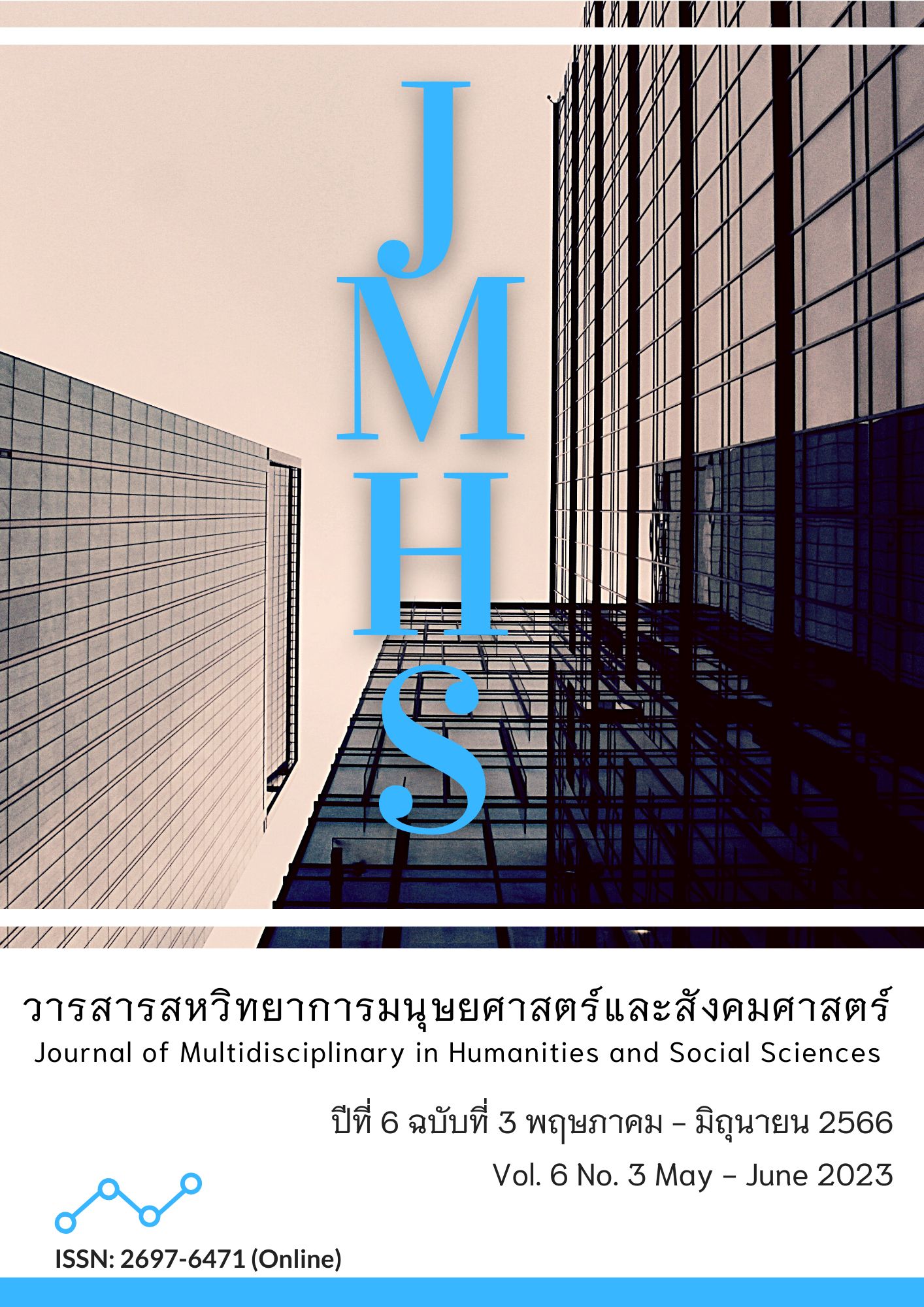An Analysis of Buddhadhamma as Appeared in Vientiane’s Art Works to Promote Religious Tourism
Main Article Content
Abstract
This article aimed to study 1) the Buddhadhamma as it appeared in art works, 2) the art works in the Vientiane capital, Lao PDR, and 3) the Buddhadhamma as it appeared in Vientiane’s Art works to promote religious tourism. The research tools were a survey, observation, and interview. The data collected was documentary and fieldwork, and descriptive analysis was used for the result submission. It was found that the Buddhadhamma as it appeared in artworks was created as a medium to demonstrate the principles of Buddhism in the early days. Stupas as architecture are signed by Nibbana. The sculpture of Ashoka's stone pillars and the Buddha images are the Dhammachakkapavasutra, Punnakiriyavatthu, Three Characteristics, The Eightfold Paths, DasaParami, Four Noble Truths, and Nibbana. Art works in Vientiane, Lao PDR, found that the arts consisted of 2 architectures, Pha That Luang and Sim Wat Ong Tue, 5 sculptures, Buddha images of Phra Chao Yai in Paeng at Sim and Buddha Hall at Wat Phra Kaew, and mural paintings at Sisaket Temple. The Buddhadharma appeared in the arts in Vientiane to promote religious Tourism. The architecture of Phra That Luang and Sim Wat Ong Tue is Punnakiriya Vatthu, Three Characteristics, Eightfold Paths, and Nibbana. The sculptures at Phra Chao Yai In Paeng at Sim In Paeng temple and the Buddha Hall at Wat Phra Kaeo are the Three Characteristics: Noble Truth, Eightfold Paths, and Nibbana. Mural paintings in Vessantara Jataka at Sisaket Temple are Punnakiriya Vatthu, Noble Truth, Eightfold Paths, and Nibbana. These principles promote religious tourism that creates a spiritual dimension that is a sign of peace and happiness for the mind. Buddhadhamma symbolizes aesthetic beauty and economic activities that generate large amounts of income for the Lao government and people.
Article Details

This work is licensed under a Creative Commons Attribution-NonCommercial-NoDerivatives 4.0 International License.
Views and opinions appearing in the Journal it is the responsibility of the author of the article, and does not constitute the view and responsibility of the editorial team.
References
กันหา สีกุนวง. (2559). ฮางฮดสรง: สื่อสัญลักษณ์ สุนทรียภาพ พิธีกรรมและความเชื่อ ใน แขวงหลวงพระบาง นครหลวงเวียงจันทน์ และ แขวงจำปาสัก ของ สปป ลาว. วารสารศิลปกรรมศาสตร์ มหาวิทยาลัยขอนแก่น, 8(2), 60-77.
คำสุข แก้ววงสาย. (2559). สิมเวียงจันทน์: รูปแบบ สุนทรียภาพ และคติสัญลักษณ์. วารสารศิลปกรรมศาสตร์ มหาวิทยาลัยขอนแก่น, 8(2), 44-59.
ฉลาดชาย รมิตานนท์. (2527). ผีเจ้านาย. เชียงใหม่: มหาวิทยาลัยเชียงใหม่.
เชษฐิ์ ติงสัญชลี. (2558). ประวัติศาสตร์ศิลปะอินเดียและเอเชียตะวันออกเฉียงใต้ รูปแบบ พัฒนาการและความหมาย. นนทบุรี: มิวเซียมเพรส.
บุรินทร์ เปล่งดีสกุล. (2555).พลวัตของจิตรกรรมร่วมสมัยลาวจากยุคอาณานิคมถึงปัจจุบัน. วารสารศิลปกรรมศาสตร์ มหาวิทยาลัยขอนแก่น, 4(1), 30–57.
พระพรหมคุณาภรณ์ (ป.อ. ปยุตฺโต). (2551). พจนานุกรมพุทธศาสน์ ฉบับประมวลศัพท์. (พิมพ์ครั้งที่ 12). กรุงเทพฯ: มหาวิทยาลัยมหาจุฬาลงกรณราชวิทยาลัย.
พระศรีสังคม ชญานุวฑฺโฒ และ ปาริชาติ วไลยเสถียร. (2563) การจัดการท่องเที่ยวเชิงพุทธศาสนา:รูปแบบและเครือข่ายการจัดการของวัดในสังคมไทย. วารสารมหาจุฬาวิชาการ, 3(7), 238-249.
มหาคำ จำปาแก้วมณี และคณะ. (2539). ประวัติศาสตร์ลาว. (สุวิทย์ ธีรศาศวัติ, ผู้แปล). ขอนแก่น: คณะมนุษยศาสตร์และสังคมศาสตร์, มหาวิทยาลัยขอนแก่น.
มหาวิทยาลัยมหาจุฬาลงกรณราชวิทยาลัย. (2539). พระไตรปิฎกภาษาไทย ฉบับมหาจุฬาลงกรณราชวิทยาลัย. กรุงเทพฯ: มหาวิทยาลัยมหาจุฬาลงกรณราชวิทยาลัย.
รุ่งโรจน์ ธรรมรุ่งเรือง. (2565). รู้เรื่องสถูปเจดีย์: ที่มา ความหมาย ศิลปกรรมเจดีย์ในประเทศไทยทุกยุคทุกสมัย. นนทบุรี: มิวเซียมเพรส.
วัชรินทร์ สินศิริ. (2559). จิตรกรรมหลวงพระบาง ผลกระทบต่อสังคมก่อนและหลังปี ค.ศ. 1995. วารสารศิลปกรรมศาสตร์ มหาวิทยาลัยขอนแก่น, 8(2), 315-339.
สงวน รอดบุญ. (2545). พุทธศิลปลาว. กรุงเทพฯ: สำนักพิมพ์สายธาร.
Lall V. (2014). The Golden Lands: Architecture of The Buddhist World. Hong Kong: J.F. Publishing.
Revire, N., & Soomjinda, P. (2023). Decoding Southeast Asian Art: Studies in Honor of Piriya Krairiksh. Bangkok: River Books.


